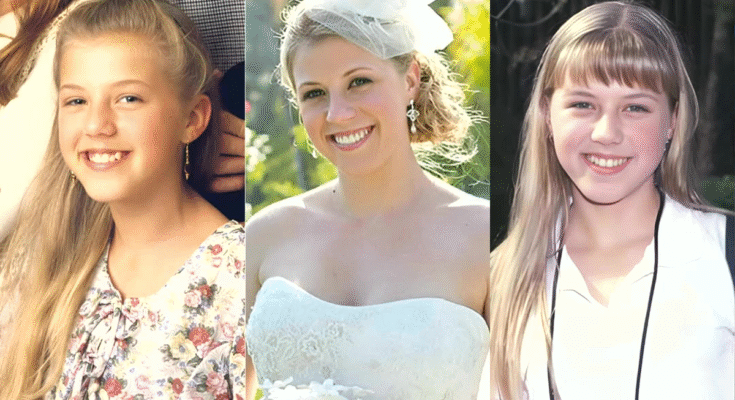How a quirky, attention-seeking middle child became television’s most relatable role model for finding your voice
Introduction: The Power of Being “In Between”
In the pantheon of beloved television characters, few have captured the authentic experience of growing up quite like Stephanie Tanner. Portrayed with remarkable depth and humor by Jodie Sweetin, Stephanie emerged as the beating heart of Full House—not because she was the oldest or the youngest, but precisely because she was caught in the middle, fighting to be seen, heard, and valued for who she truly was.
Stephanie’s journey from a spirited, insecure middle child to a confident, empowered woman represents one of television’s most honest portrayals of adolescent growth. Her story resonates across generations because it speaks to universal truths: the struggle for identity, the pain of feeling overlooked, and the triumph of discovering that your worth isn’t determined by where you stand in comparison to others.
Through eight seasons of Full House and the continuation in Fuller House, Stephanie Tanner evolved from seeking external validation to finding inner strength, teaching millions of viewers that the middle doesn’t mean invisible—it means you have a unique perspective that only you can offer.
Chapter 1: Growing Up in the Shadows and Light
The Middle Child’s Dilemma
Being the second of three daughters in the Tanner household meant Stephanie occupied a complex emotional territory. While DJ commanded respect as the responsible eldest and Michelle captured hearts as the adorable baby, Stephanie often found herself in the uncomfortable space between—too old to be cute, too young to be taken seriously.
This positioning created what psychologists recognize as “middle child syndrome,” but Stephanie’s experience went deeper than textbook definitions. After losing her mother Pam at such a young age, the family dynamics shifted dramatically. DJ stepped into a maternal role, Michelle remained the protected youngest, and Stephanie… Stephanie had to figure out where she belonged in this new reality.

Her early years were marked by a desperate creativity in seeking attention—whether through her infamous “How rude!” catchphrase, her elaborate schemes to get noticed, or her genuine moments of vulnerability when the weight of being overlooked became too much to bear. These weren’t simply comedic moments; they were authentic representations of a child learning to navigate complex family dynamics while processing grief and growing up.
Finding Family in Unexpected Places
The arrival of Uncle Jesse and Joey Gladstone transformed the Tanner household into something unprecedented on television—a chosen family that proved love comes in many forms. For Stephanie, Jesse’s rebellious coolness and Joey’s goofy humor provided different models of adulthood than her father’s methodical approach.
Jesse, with his leather jackets and rock star dreams, showed Stephanie that being different wasn’t just acceptable—it was valuable. Joey’s comedy and childlike wonder reminded her that growing up didn’t mean losing your sense of fun. Together with Danny’s unwavering love and support, these men created a safety net that allowed Stephanie to experiment with her identity without fear of abandonment.
This extended family structure became crucial for Stephanie’s development. She learned that family isn’t just about biological connections—it’s about the people who show up, who listen, and who love you through your most awkward phases.
Chapter 2: The Art of Standing Out While Fitting In
Teenage Turbulence and Self-Discovery
Stephanie’s adolescent years brought new challenges as she navigated the treacherous waters of teenage identity formation. Unlike DJ’s relatively smooth transition into young adulthood, Stephanie’s path was marked by more dramatic ups and downs, reflecting the reality that not everyone’s coming-of-age story follows the same trajectory.
Her struggles with self-esteem were painfully authentic. She dealt with body image issues, friendship drama, and the constant comparison to her sisters that many middle children experience. What made Stephanie’s journey compelling was her refusal to accept defeat—even when she made mistakes or faced rejection, she bounced back with renewed determination to find her place in the world.

Her romantic interests and friendships provided important learning experiences about trust, loyalty, and self-worth. Through crushes, heartbreaks, and the complex dynamics of teenage social life, Stephanie learned that her value didn’t depend on others’ approval—a lesson that would prove crucial as she matured.
The Search for Individual Identity
One of Stephanie’s most significant character developments was her journey toward understanding that being different from her sisters wasn’t a flaw to overcome—it was her strength. DJ’s academic excellence and natural leadership were admirable, but they weren’t Stephanie’s path. Michelle’s natural charm and innocence were endearing, but they weren’t Stephanie’s gifts either.
Stephanie’s gifts lay in her emotional intelligence, her humor, her ability to connect with people who felt like outsiders, and her resilience in the face of challenges. She became the family member who could bridge different perspectives, who could find humor in difficult situations, and who could offer support to anyone feeling overlooked or undervalued.
This realization didn’t happen overnight. It was a gradual process of trial and error, of learning from mistakes, and of slowly building confidence in her own unique qualities.
Chapter 3: The Evolution of Sisterhood
Beyond Sibling Rivalry
Stephanie’s relationships with DJ and Michelle evolved from simple sibling dynamics into something much more complex and meaningful. With DJ, what began as competition for attention gradually transformed into mutual respect and genuine friendship. Stephanie learned to appreciate DJ’s wisdom and guidance while DJ came to value Stephanie’s emotional insights and humor.
The turning point in their relationship came when Stephanie stopped trying to be like DJ and started appreciating what she herself brought to the family. This shift allowed both sisters to support each other more effectively, creating a bond that extended beyond typical sibling connections.

Protecting and Nurturing Michelle
Stephanie’s relationship with Michelle revealed her natural nurturing instincts and leadership abilities. As the middle child, Stephanie often served as a bridge between Michelle’s childlike perspective and the adult world. She became Michelle’s protector, confidante, and guide, helping her navigate challenges with patience and understanding.
This protective role helped Stephanie develop confidence in her own judgment and abilities. Through caring for Michelle, she discovered that she had valuable insights to offer and that her position in the family—far from being a disadvantage—gave her a unique perspective that benefited everyone.
The Strength of the Tanner Triangle
The three Tanner sisters ultimately formed a powerful support system that exemplified the best aspects of siblinghood. Each brought different strengths: DJ’s wisdom and responsibility, Stephanie’s emotional intelligence and humor, and Michelle’s optimism and innocence. Together, they created a dynamic that was stronger than any individual component.
Stephanie’s role in this triangle was crucial—she served as the emotional bridge, the mediator, and often the voice of reason when conflicts arose. Her position in the middle, which had once felt like a burden, became her superpower.
Chapter 4: Fuller House – The Adult Chapter
Coming Full Circle
The Netflix sequel Fuller House provided an opportunity to see how Stephanie’s childhood experiences shaped her adult life. No longer the attention-seeking middle child, adult Stephanie had evolved into a confident, independent woman who understood her worth and embraced her unique path in life.

Her decision to move in with DJ to help raise her nephews echoed the family support system that had nurtured her own growth. Stephanie’s role in the Fuller House household demonstrated how the lessons she learned about family, sacrifice, and love had prepared her to be a positive influence on the next generation.
Professional Success and Personal Growth
Adult Stephanie’s career in the music industry reflected her creative spirit and her ability to forge her own path. She had learned to pursue her passions without seeking external validation, a significant evolution from the child who desperately wanted to be noticed and appreciated.
Her romantic relationships in Fuller House showed a woman who knew her worth and wouldn’t settle for less than she deserved. The insecure teenager who had struggled with self-esteem had become an adult who approached relationships with confidence and clear boundaries.
The Mentor Role
Perhaps most significantly, Stephanie’s relationship with DJ’s children, particularly her role as an aunt and mentor, demonstrated how her own experiences had prepared her to guide others through similar challenges. She became the adult she had needed as a child—someone who saw value in the overlooked, who celebrated uniqueness, and who provided unconditional support during difficult times.
Chapter 5: Cultural Impact and Lasting Legacy
Representation That Mattered
Stephanie Tanner’s character provided representation for millions of middle children who saw their own struggles reflected on screen. Her journey validated the experiences of anyone who had ever felt overlooked, undervalued, or caught between competing demands for attention and recognition.

Her character development showed that middle children aren’t doomed to invisibility—they often develop unique strengths like adaptability, empathy, and the ability to see multiple perspectives. Stephanie’s growth into a confident adult proved that early struggles with identity and self-worth don’t define your ultimate potential.
Lessons in Resilience
Through Stephanie’s various challenges—from feeling overlooked in her family to dealing with teenage insecurities to finding her professional path—viewers learned valuable lessons about resilience. She demonstrated that setbacks aren’t permanent, that growth often comes through struggle, and that your worth isn’t determined by others’ perceptions of you.
Her humor in the face of adversity, her willingness to keep trying despite failures, and her ultimate success in finding her place in the world provided a roadmap for anyone facing similar challenges.
The Power of Authentic Storytelling
Stephanie’s character arc succeeded because it never shied away from the messy, complicated reality of growing up. Her struggles felt real because they were based on genuine human experiences. Her victories felt earned because viewers had witnessed her work through genuine challenges.
This authenticity made Stephanie a character that viewers could grow with, learn from, and ultimately see themselves in. Her story reminded audiences that everyone’s journey is different, and that finding your place in the world is often a longer, more complex process than it appears from the outside.
Conclusion: The Middle Child Who Found Her Voice
Stephanie Tanner’s journey from a quirky, attention-seeking middle child to a confident, empowered woman stands as one of television’s most authentic and inspiring character arcs. Her story reminds us that feeling overlooked or undervalued doesn’t reflect your true worth—it often means you’re developing the empathy and resilience that will become your greatest strengths.
Through Stephanie’s eyes, viewers learned that the middle isn’t a place of invisibility—it’s a vantage point that offers unique perspectives and opportunities for growth. Her evolution demonstrated that self-worth comes from within, that family bonds can overcome any challenge, and that everyone has something valuable to contribute, regardless of where they fall in the traditional hierarchy.
Stephanie Tanner taught us that being different isn’t a problem to solve—it’s a gift to embrace. Her legacy continues to inspire anyone who has ever felt like they didn’t quite fit, reminding them that sometimes the most powerful voices come from those who had to fight to be heard.
In a world that often celebrates extremes—the oldest, the youngest, the loudest, the quietest—Stephanie Tanner championed the power of the middle ground, showing that balance, empathy, and authentic self-expression are qualities worth celebrating. Her story continues to resonate because it speaks to the universal human experience of searching for identity, belonging, and purpose.
Stephanie Tanner didn’t just find her voice—she taught millions of others how to find theirs.
Discover more inspiring character journeys and stories of personal growth at StarConnect Network, where authentic storytelling meets meaningful connection.



